University: Manage People Performance - BSBMGT502 Assignment
VerifiedAdded on 2022/08/12
|18
|2925
|341
Homework Assignment
AI Summary
This assignment solution addresses the core components of managing people performance, including skills, knowledge, and performance activities. Section A focuses on skills, presenting a one-on-one coaching scenario, a performance improvement plan, and a risk analysis. Section B delves into knowledge, covering topics such as the Australian Fair Work Act, key performance indicators (KPIs), reasons for unfair dismissal, and staff development options. Section C examines performance, outlining work requirements, performance standards, and performance indicators for a specific group of employees, alongside strategies for monitoring, evaluating, and providing feedback on employee performance. The solution incorporates practical examples and references relevant resources to provide a well-rounded understanding of people management principles.
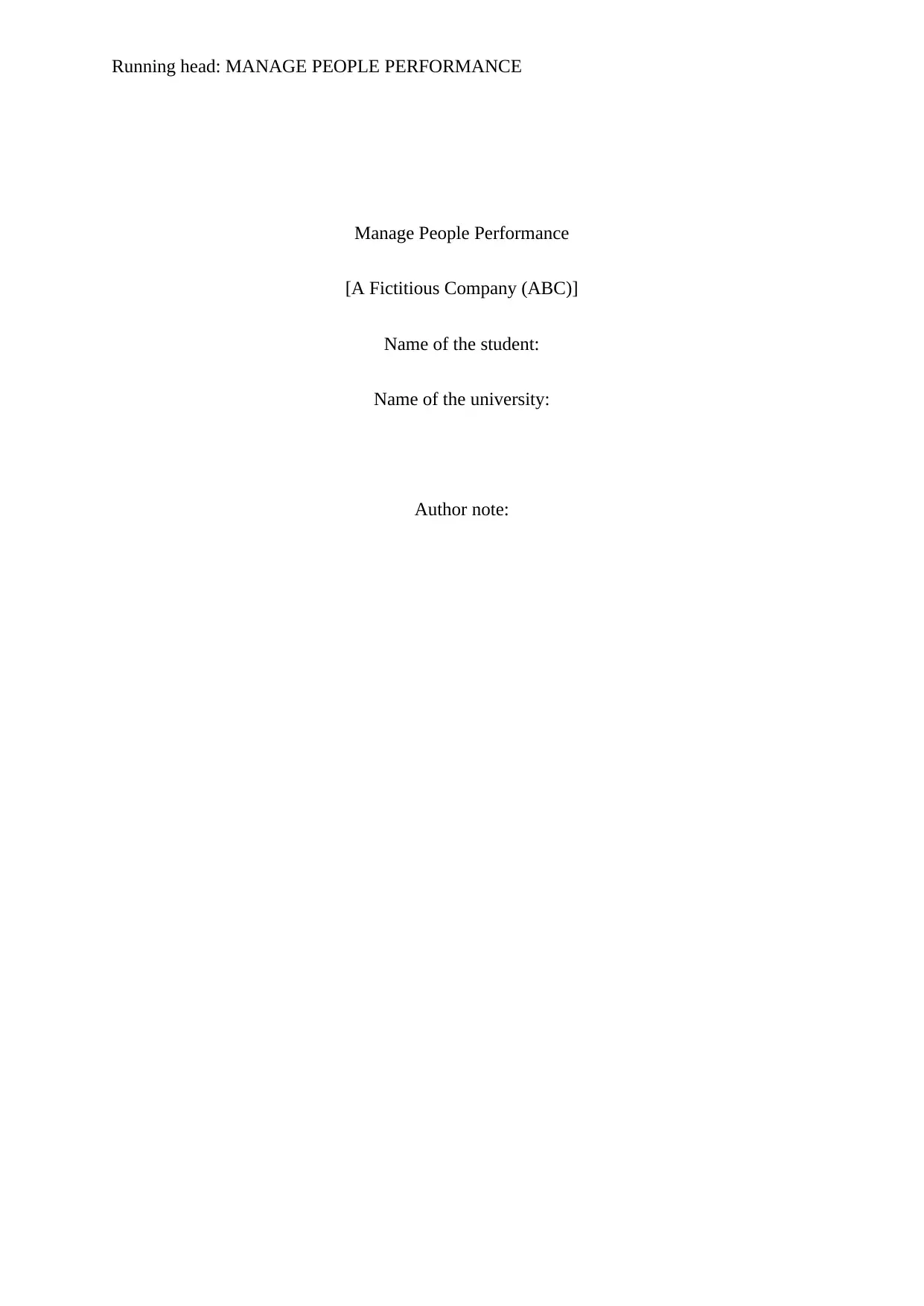
Running head: MANAGE PEOPLE PERFORMANCE
Manage People Performance
[A Fictitious Company (ABC)]
Name of the student:
Name of the university:
Author note:
Manage People Performance
[A Fictitious Company (ABC)]
Name of the student:
Name of the university:
Author note:
Paraphrase This Document
Need a fresh take? Get an instant paraphrase of this document with our AI Paraphraser
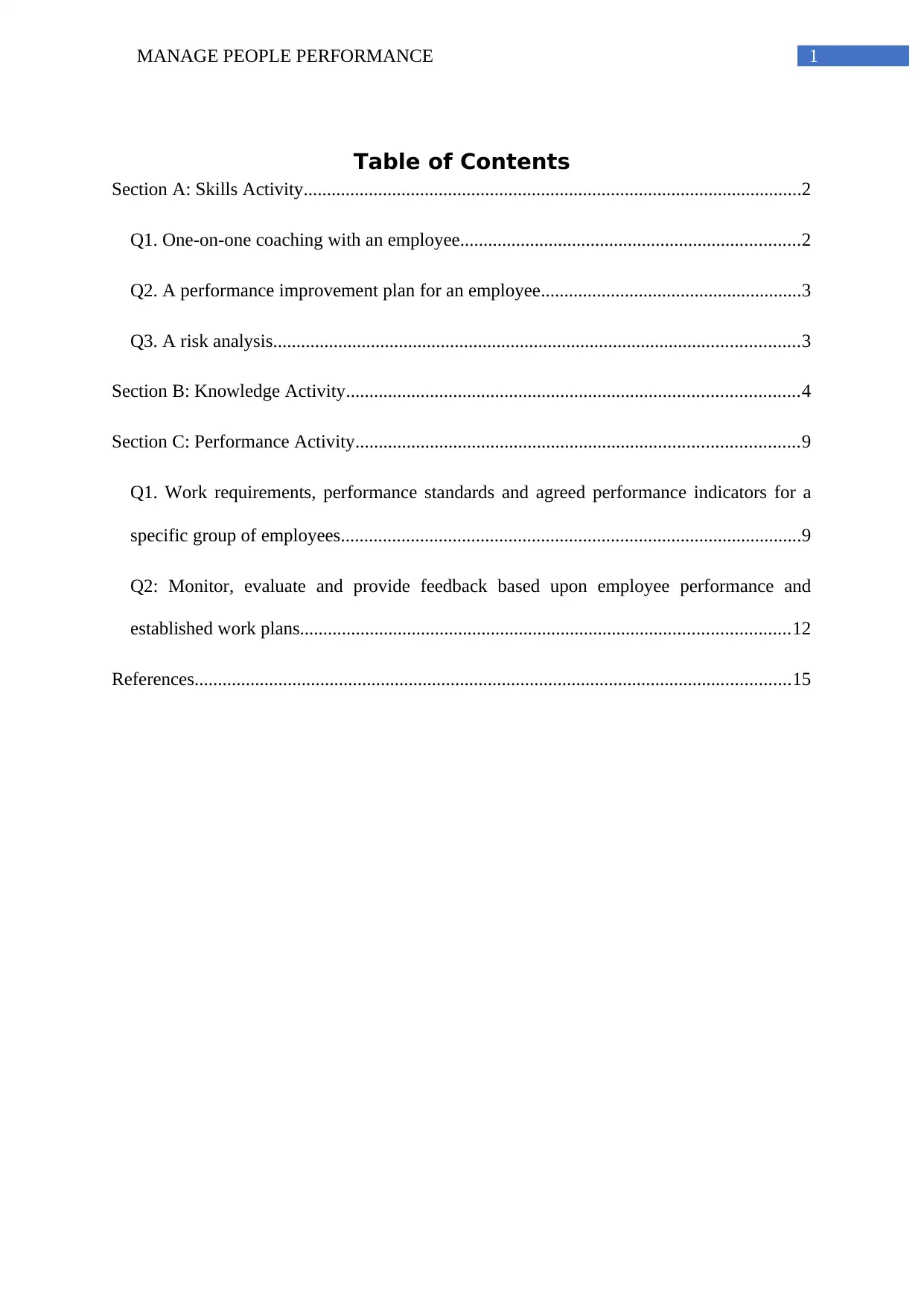
1MANAGE PEOPLE PERFORMANCE
Table of Contents
Section A: Skills Activity...........................................................................................................2
Q1. One-on-one coaching with an employee.........................................................................2
Q2. A performance improvement plan for an employee........................................................3
Q3. A risk analysis.................................................................................................................3
Section B: Knowledge Activity.................................................................................................4
Section C: Performance Activity...............................................................................................9
Q1. Work requirements, performance standards and agreed performance indicators for a
specific group of employees...................................................................................................9
Q2: Monitor, evaluate and provide feedback based upon employee performance and
established work plans.........................................................................................................12
References................................................................................................................................15
Table of Contents
Section A: Skills Activity...........................................................................................................2
Q1. One-on-one coaching with an employee.........................................................................2
Q2. A performance improvement plan for an employee........................................................3
Q3. A risk analysis.................................................................................................................3
Section B: Knowledge Activity.................................................................................................4
Section C: Performance Activity...............................................................................................9
Q1. Work requirements, performance standards and agreed performance indicators for a
specific group of employees...................................................................................................9
Q2: Monitor, evaluate and provide feedback based upon employee performance and
established work plans.........................................................................................................12
References................................................................................................................................15

2MANAGE PEOPLE PERFORMANCE
Section A: Skills Activity
Q1. One-on-one coaching with an employee
Anand Sanwal, the CEO and founder of ‘ABC’, a company that provides predictive
intelligence on the health of private companies, admits that he wasn’t always good at running
one-on-one meetings with his team members. “I made a series of bad assumptions,” says
Anand, who has standing one-on-one meetings with his team members every two weeks
(Harvard Business Review, 2020).
“I used to open with a generic, ‘How’s it going?’ But often the answers were terse and
not very substantive.” Anand realized that he needed to get more from these meetings — both
for his sake and the sake of his six direct reports. So now before each one-on-one, Anand
inserts a series of questions into the meeting calendar invites (Harvard Business Review,
2020).
Recently, he had a one-on-one with one of his star performers — we’ll call him Sam.
“He is a rock star,” says Anand. “We throw a lot at him and everything he does, he does
well.” After Anand and Sam had discussed tactical issues, Anand turned to the questions. He
asked Sam, “What’s your favorite part about what you do?” (Harvard Business Review,
2020)
Based on that one-on-one, Anand realized that he needed to do a better job defining
Sam’s role. “We didn’t get that done in the 45-minute meeting, but it started a conversation
about how to get stuff off of his plate, whether we need to hire other people, or whether we
need to stop doing certain things,” he says. “It was a good talk and something actionable
came out of it (Harvard Business Review, 2020).”
Section A: Skills Activity
Q1. One-on-one coaching with an employee
Anand Sanwal, the CEO and founder of ‘ABC’, a company that provides predictive
intelligence on the health of private companies, admits that he wasn’t always good at running
one-on-one meetings with his team members. “I made a series of bad assumptions,” says
Anand, who has standing one-on-one meetings with his team members every two weeks
(Harvard Business Review, 2020).
“I used to open with a generic, ‘How’s it going?’ But often the answers were terse and
not very substantive.” Anand realized that he needed to get more from these meetings — both
for his sake and the sake of his six direct reports. So now before each one-on-one, Anand
inserts a series of questions into the meeting calendar invites (Harvard Business Review,
2020).
Recently, he had a one-on-one with one of his star performers — we’ll call him Sam.
“He is a rock star,” says Anand. “We throw a lot at him and everything he does, he does
well.” After Anand and Sam had discussed tactical issues, Anand turned to the questions. He
asked Sam, “What’s your favorite part about what you do?” (Harvard Business Review,
2020)
Based on that one-on-one, Anand realized that he needed to do a better job defining
Sam’s role. “We didn’t get that done in the 45-minute meeting, but it started a conversation
about how to get stuff off of his plate, whether we need to hire other people, or whether we
need to stop doing certain things,” he says. “It was a good talk and something actionable
came out of it (Harvard Business Review, 2020).”
⊘ This is a preview!⊘
Do you want full access?
Subscribe today to unlock all pages.

Trusted by 1+ million students worldwide
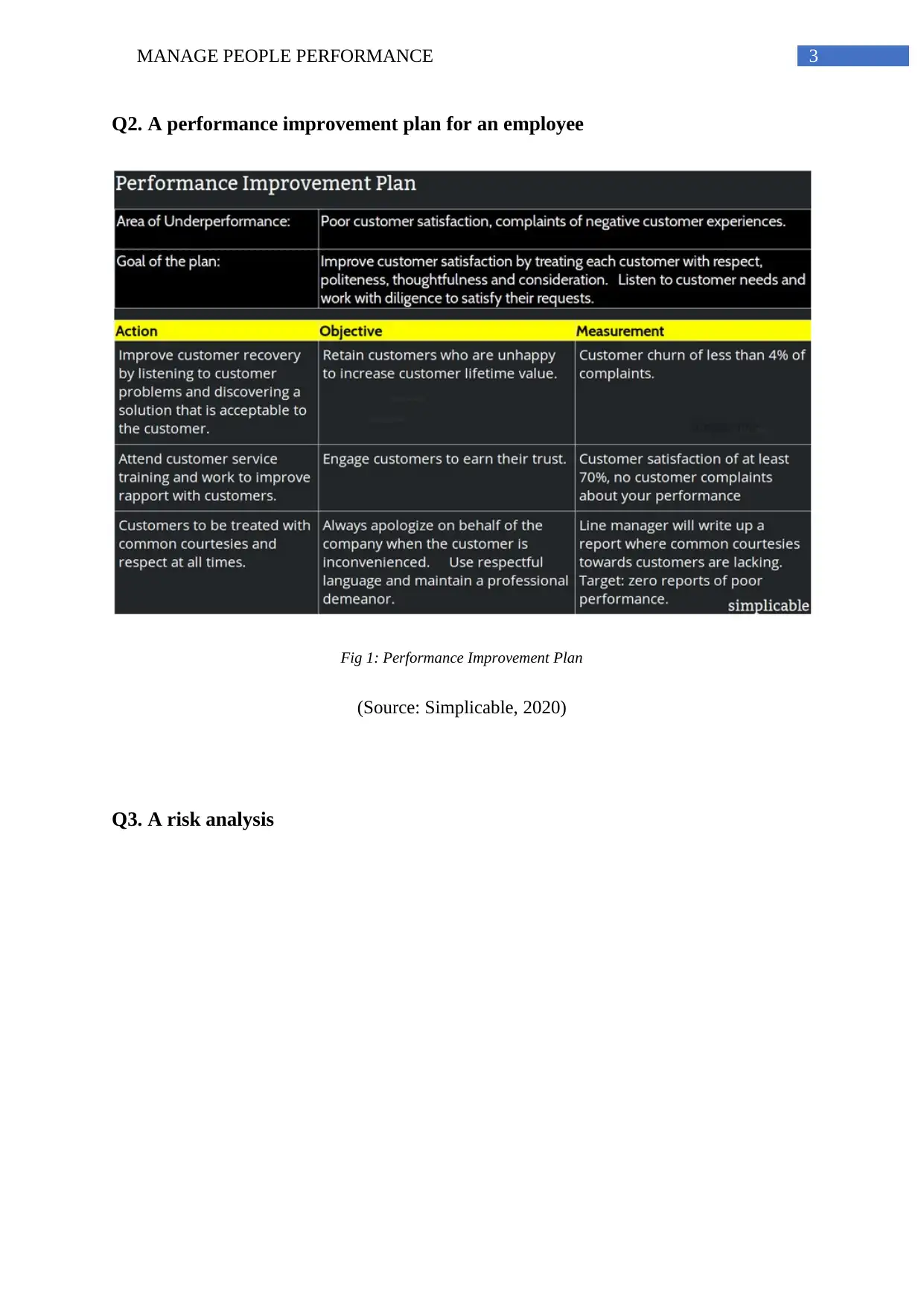
3MANAGE PEOPLE PERFORMANCE
Q2. A performance improvement plan for an employee
Fig 1: Performance Improvement Plan
(Source: Simplicable, 2020)
Q3. A risk analysis
Q2. A performance improvement plan for an employee
Fig 1: Performance Improvement Plan
(Source: Simplicable, 2020)
Q3. A risk analysis
Paraphrase This Document
Need a fresh take? Get an instant paraphrase of this document with our AI Paraphraser
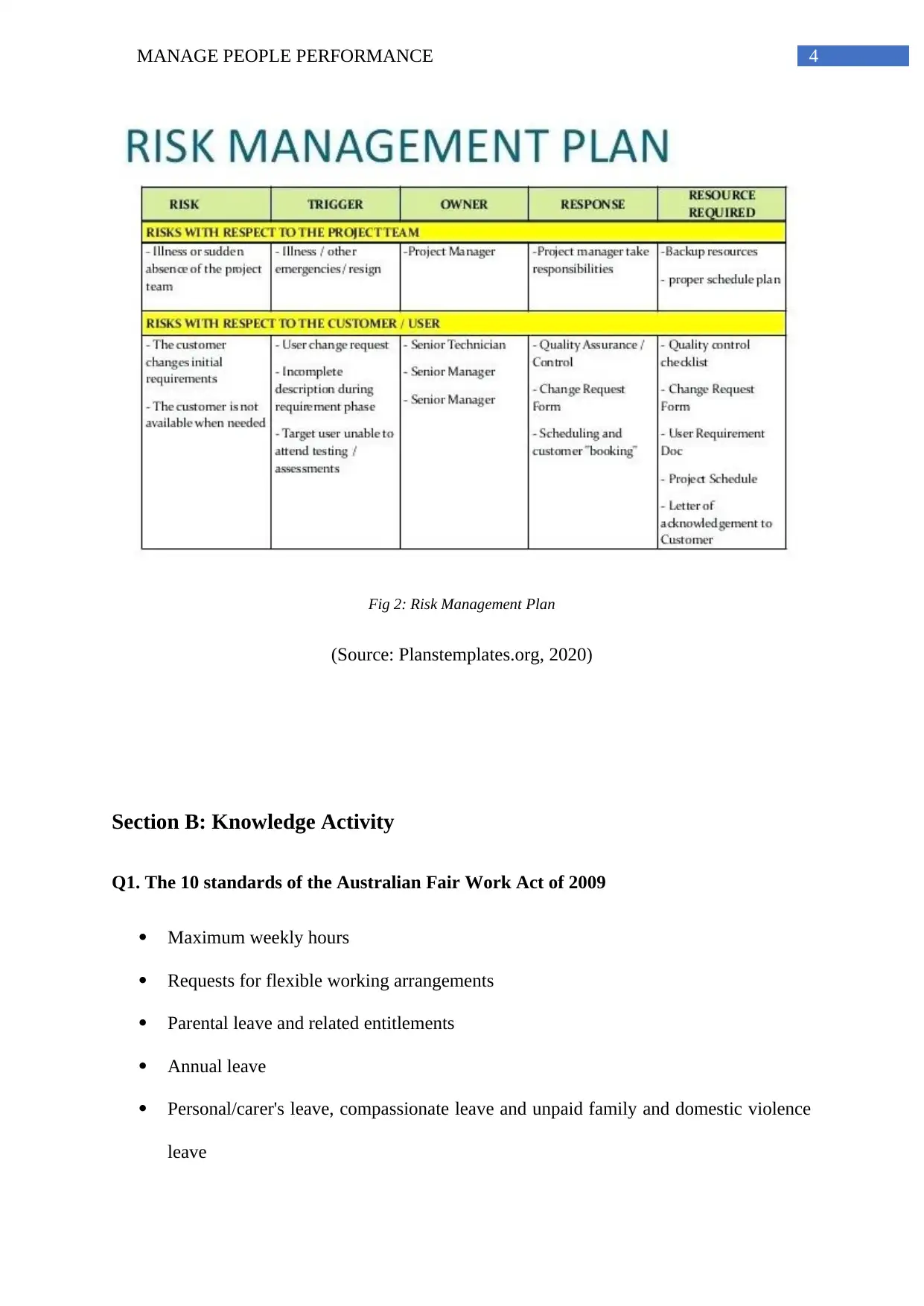
4MANAGE PEOPLE PERFORMANCE
Fig 2: Risk Management Plan
(Source: Planstemplates.org, 2020)
Section B: Knowledge Activity
Q1. The 10 standards of the Australian Fair Work Act of 2009
Maximum weekly hours
Requests for flexible working arrangements
Parental leave and related entitlements
Annual leave
Personal/carer's leave, compassionate leave and unpaid family and domestic violence
leave
Fig 2: Risk Management Plan
(Source: Planstemplates.org, 2020)
Section B: Knowledge Activity
Q1. The 10 standards of the Australian Fair Work Act of 2009
Maximum weekly hours
Requests for flexible working arrangements
Parental leave and related entitlements
Annual leave
Personal/carer's leave, compassionate leave and unpaid family and domestic violence
leave
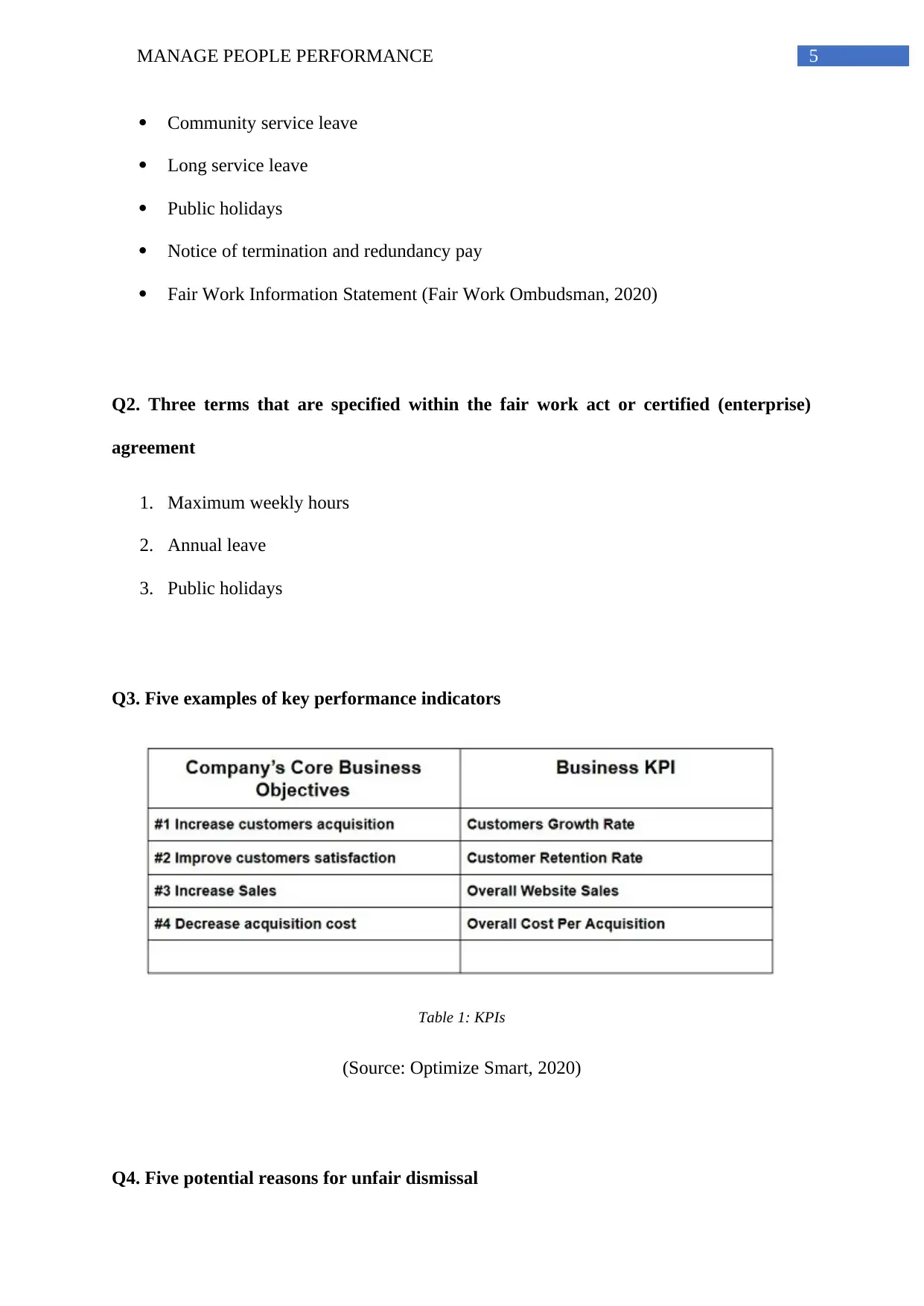
5MANAGE PEOPLE PERFORMANCE
Community service leave
Long service leave
Public holidays
Notice of termination and redundancy pay
Fair Work Information Statement (Fair Work Ombudsman, 2020)
Q2. Three terms that are specified within the fair work act or certified (enterprise)
agreement
1. Maximum weekly hours
2. Annual leave
3. Public holidays
Q3. Five examples of key performance indicators
Table 1: KPIs
(Source: Optimize Smart, 2020)
Q4. Five potential reasons for unfair dismissal
Community service leave
Long service leave
Public holidays
Notice of termination and redundancy pay
Fair Work Information Statement (Fair Work Ombudsman, 2020)
Q2. Three terms that are specified within the fair work act or certified (enterprise)
agreement
1. Maximum weekly hours
2. Annual leave
3. Public holidays
Q3. Five examples of key performance indicators
Table 1: KPIs
(Source: Optimize Smart, 2020)
Q4. Five potential reasons for unfair dismissal
⊘ This is a preview!⊘
Do you want full access?
Subscribe today to unlock all pages.

Trusted by 1+ million students worldwide

6MANAGE PEOPLE PERFORMANCE
1. Conduct/Misconduct
Minor issues of conduct/misconduct such as poor timekeeping can usually be handled
by speaking informally to the employee.
When such behaviours escalate or persist, though, disciplinary warnings (1st or 2nd
written, or even final written) can be given on grounds of misconduct.
There is no requirement to start at a 1st level warning if the circumstances warrant a
higher level warning being issued.
Continuing misconduct will eventually result in a dismissal on ‘grounds of
misconduct’.
Very serious conduct issues, such as theft, or discriminatory behaviour are usually
regarded as gross misconduct.
A gross misconduct finding will result in the employee’s summary dismissal i.e.
dismissal without notice (the only occasion when you can dismiss without notice).
2. Capability/Performance
This heading includes dismissals for two different reasons; capability – meaning ill health or
poor performance.
Capability can include ill health, for example if an employee has a persistent or long-term
illness such as cancer that makes it very difficult to do their job. Before dismissal the
employer will need to:
Consider how the employee can be supported (particularly if they have a disability
and reasonable adjustments need to be considered).
Allow time for the employee to recover and to monitor the situation.
1. Conduct/Misconduct
Minor issues of conduct/misconduct such as poor timekeeping can usually be handled
by speaking informally to the employee.
When such behaviours escalate or persist, though, disciplinary warnings (1st or 2nd
written, or even final written) can be given on grounds of misconduct.
There is no requirement to start at a 1st level warning if the circumstances warrant a
higher level warning being issued.
Continuing misconduct will eventually result in a dismissal on ‘grounds of
misconduct’.
Very serious conduct issues, such as theft, or discriminatory behaviour are usually
regarded as gross misconduct.
A gross misconduct finding will result in the employee’s summary dismissal i.e.
dismissal without notice (the only occasion when you can dismiss without notice).
2. Capability/Performance
This heading includes dismissals for two different reasons; capability – meaning ill health or
poor performance.
Capability can include ill health, for example if an employee has a persistent or long-term
illness such as cancer that makes it very difficult to do their job. Before dismissal the
employer will need to:
Consider how the employee can be supported (particularly if they have a disability
and reasonable adjustments need to be considered).
Allow time for the employee to recover and to monitor the situation.
Paraphrase This Document
Need a fresh take? Get an instant paraphrase of this document with our AI Paraphraser
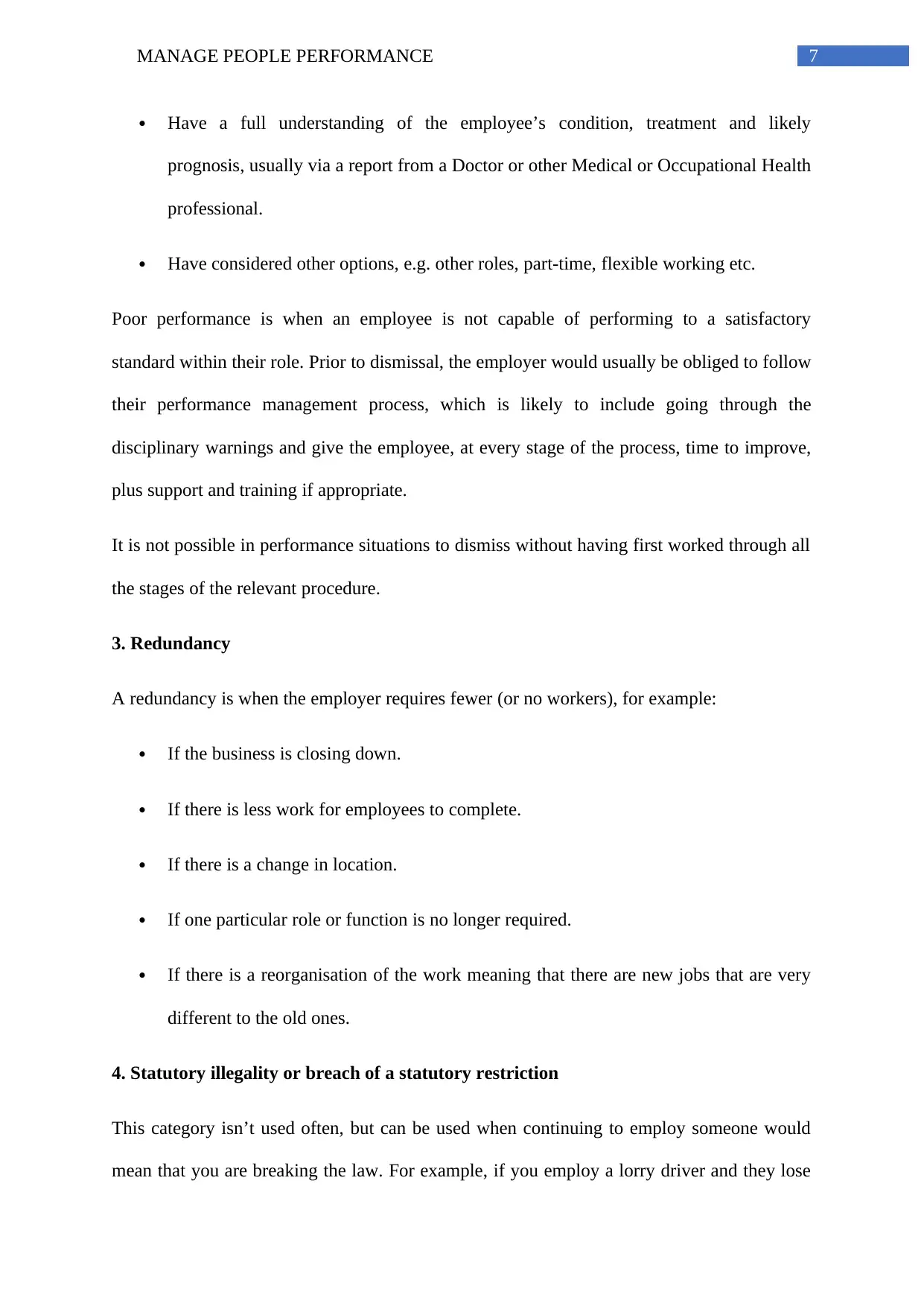
7MANAGE PEOPLE PERFORMANCE
Have a full understanding of the employee’s condition, treatment and likely
prognosis, usually via a report from a Doctor or other Medical or Occupational Health
professional.
Have considered other options, e.g. other roles, part-time, flexible working etc.
Poor performance is when an employee is not capable of performing to a satisfactory
standard within their role. Prior to dismissal, the employer would usually be obliged to follow
their performance management process, which is likely to include going through the
disciplinary warnings and give the employee, at every stage of the process, time to improve,
plus support and training if appropriate.
It is not possible in performance situations to dismiss without having first worked through all
the stages of the relevant procedure.
3. Redundancy
A redundancy is when the employer requires fewer (or no workers), for example:
If the business is closing down.
If there is less work for employees to complete.
If there is a change in location.
If one particular role or function is no longer required.
If there is a reorganisation of the work meaning that there are new jobs that are very
different to the old ones.
4. Statutory illegality or breach of a statutory restriction
This category isn’t used often, but can be used when continuing to employ someone would
mean that you are breaking the law. For example, if you employ a lorry driver and they lose
Have a full understanding of the employee’s condition, treatment and likely
prognosis, usually via a report from a Doctor or other Medical or Occupational Health
professional.
Have considered other options, e.g. other roles, part-time, flexible working etc.
Poor performance is when an employee is not capable of performing to a satisfactory
standard within their role. Prior to dismissal, the employer would usually be obliged to follow
their performance management process, which is likely to include going through the
disciplinary warnings and give the employee, at every stage of the process, time to improve,
plus support and training if appropriate.
It is not possible in performance situations to dismiss without having first worked through all
the stages of the relevant procedure.
3. Redundancy
A redundancy is when the employer requires fewer (or no workers), for example:
If the business is closing down.
If there is less work for employees to complete.
If there is a change in location.
If one particular role or function is no longer required.
If there is a reorganisation of the work meaning that there are new jobs that are very
different to the old ones.
4. Statutory illegality or breach of a statutory restriction
This category isn’t used often, but can be used when continuing to employ someone would
mean that you are breaking the law. For example, if you employ a lorry driver and they lose

8MANAGE PEOPLE PERFORMANCE
their driving licence (and you have no other work for them), or the employee’s right to work
in the UK expires.
5. Some Other Substantial Reason (SOSR)
Some would say that the SOSR category is the ‘dustbin’ category, and to some extent this is
true – it is used for all the dismissals that don’t fit into the other four categories.
There isn’t legal definition of the dismissals that can be included in this category, but some
typical examples would include:
Expiry of a fixed term contract, or dismissing temporary employees (e.g. employees
covering an absence or maternity cover) to allow the original employee to return.
When a client refuses to work with an employee and there is no other work that
employee can undertake.
If an employee doesn’t agree to changes to their terms and conditions, you could
potentially dismiss them and re-engage them on new terms and conditions (after
undergoing consultation and exploring all the options of course).
If there is a personality clash that’s causing a substantial issue to the business.
If there is a significant conflict of interest e.g. a senior employee has a partner who
works for a competitor and is a serious threat.
Be aware that if dismissing on grounds of SOSR you need to have a robust case, as any claim
to a tribunal would result in your approach, reasoning and reasonableness being thoroughly
tested. This might be a ‘dustbin’ category but be careful of overusing it or proceeding without
a strong enough case to proceed (Jaluch HR & Training, 2020).
Q5. Identify three staff development options
their driving licence (and you have no other work for them), or the employee’s right to work
in the UK expires.
5. Some Other Substantial Reason (SOSR)
Some would say that the SOSR category is the ‘dustbin’ category, and to some extent this is
true – it is used for all the dismissals that don’t fit into the other four categories.
There isn’t legal definition of the dismissals that can be included in this category, but some
typical examples would include:
Expiry of a fixed term contract, or dismissing temporary employees (e.g. employees
covering an absence or maternity cover) to allow the original employee to return.
When a client refuses to work with an employee and there is no other work that
employee can undertake.
If an employee doesn’t agree to changes to their terms and conditions, you could
potentially dismiss them and re-engage them on new terms and conditions (after
undergoing consultation and exploring all the options of course).
If there is a personality clash that’s causing a substantial issue to the business.
If there is a significant conflict of interest e.g. a senior employee has a partner who
works for a competitor and is a serious threat.
Be aware that if dismissing on grounds of SOSR you need to have a robust case, as any claim
to a tribunal would result in your approach, reasoning and reasonableness being thoroughly
tested. This might be a ‘dustbin’ category but be careful of overusing it or proceeding without
a strong enough case to proceed (Jaluch HR & Training, 2020).
Q5. Identify three staff development options
⊘ This is a preview!⊘
Do you want full access?
Subscribe today to unlock all pages.

Trusted by 1+ million students worldwide
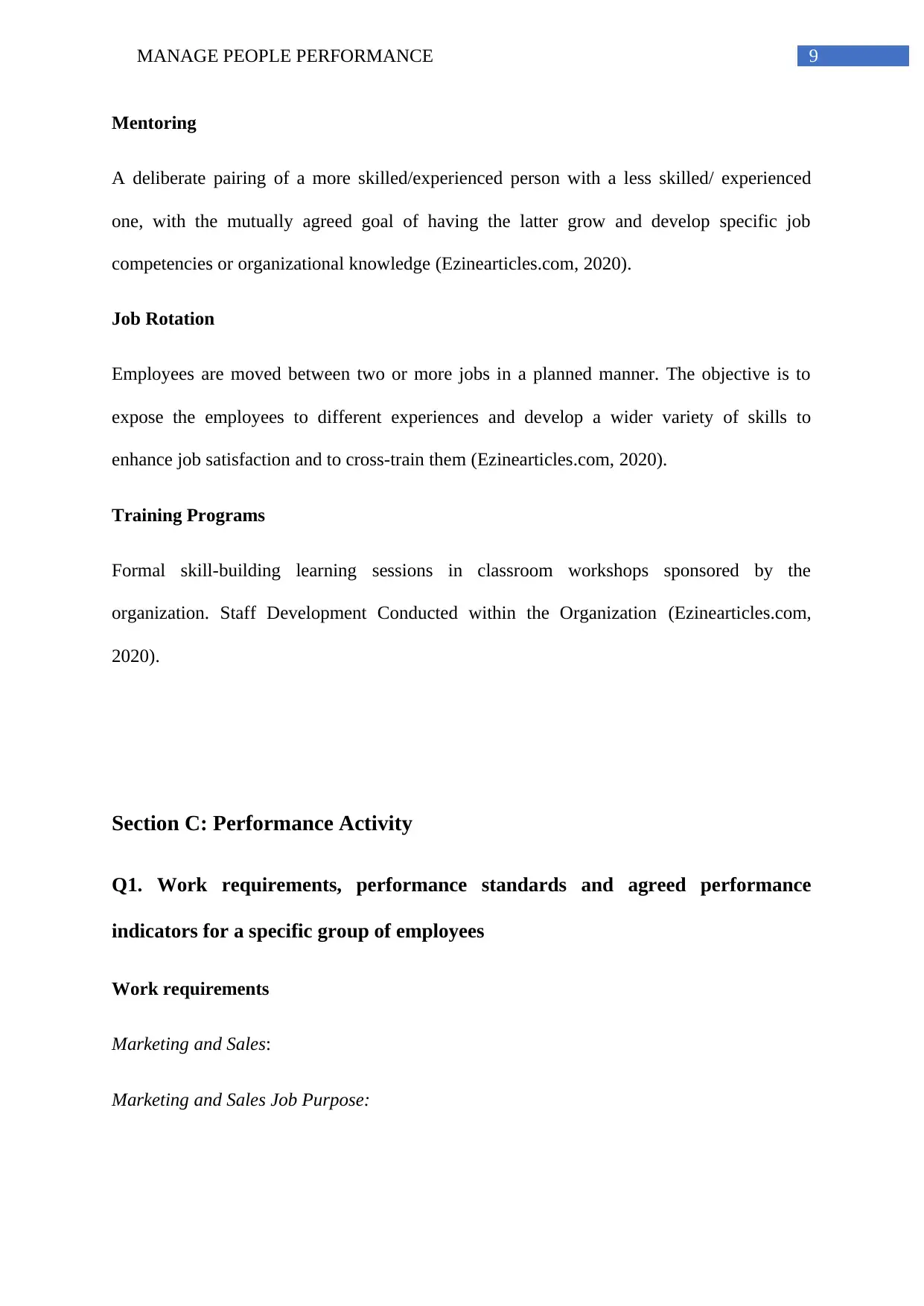
9MANAGE PEOPLE PERFORMANCE
Mentoring
A deliberate pairing of a more skilled/experienced person with a less skilled/ experienced
one, with the mutually agreed goal of having the latter grow and develop specific job
competencies or organizational knowledge (Ezinearticles.com, 2020).
Job Rotation
Employees are moved between two or more jobs in a planned manner. The objective is to
expose the employees to different experiences and develop a wider variety of skills to
enhance job satisfaction and to cross-train them (Ezinearticles.com, 2020).
Training Programs
Formal skill-building learning sessions in classroom workshops sponsored by the
organization. Staff Development Conducted within the Organization (Ezinearticles.com,
2020).
Section C: Performance Activity
Q1. Work requirements, performance standards and agreed performance
indicators for a specific group of employees
Work requirements
Marketing and Sales:
Marketing and Sales Job Purpose:
Mentoring
A deliberate pairing of a more skilled/experienced person with a less skilled/ experienced
one, with the mutually agreed goal of having the latter grow and develop specific job
competencies or organizational knowledge (Ezinearticles.com, 2020).
Job Rotation
Employees are moved between two or more jobs in a planned manner. The objective is to
expose the employees to different experiences and develop a wider variety of skills to
enhance job satisfaction and to cross-train them (Ezinearticles.com, 2020).
Training Programs
Formal skill-building learning sessions in classroom workshops sponsored by the
organization. Staff Development Conducted within the Organization (Ezinearticles.com,
2020).
Section C: Performance Activity
Q1. Work requirements, performance standards and agreed performance
indicators for a specific group of employees
Work requirements
Marketing and Sales:
Marketing and Sales Job Purpose:
Paraphrase This Document
Need a fresh take? Get an instant paraphrase of this document with our AI Paraphraser
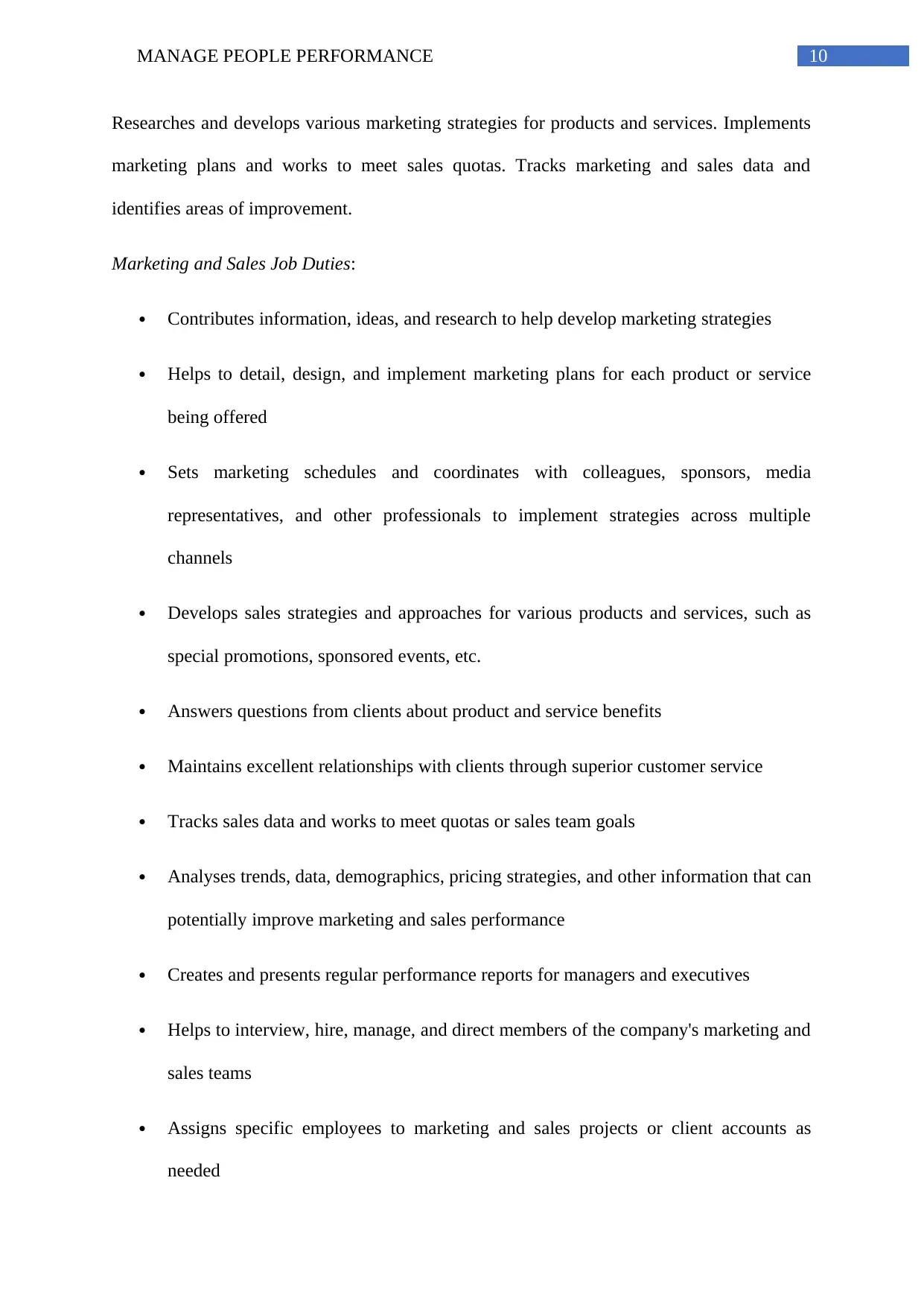
10MANAGE PEOPLE PERFORMANCE
Researches and develops various marketing strategies for products and services. Implements
marketing plans and works to meet sales quotas. Tracks marketing and sales data and
identifies areas of improvement.
Marketing and Sales Job Duties:
Contributes information, ideas, and research to help develop marketing strategies
Helps to detail, design, and implement marketing plans for each product or service
being offered
Sets marketing schedules and coordinates with colleagues, sponsors, media
representatives, and other professionals to implement strategies across multiple
channels
Develops sales strategies and approaches for various products and services, such as
special promotions, sponsored events, etc.
Answers questions from clients about product and service benefits
Maintains excellent relationships with clients through superior customer service
Tracks sales data and works to meet quotas or sales team goals
Analyses trends, data, demographics, pricing strategies, and other information that can
potentially improve marketing and sales performance
Creates and presents regular performance reports for managers and executives
Helps to interview, hire, manage, and direct members of the company's marketing and
sales teams
Assigns specific employees to marketing and sales projects or client accounts as
needed
Researches and develops various marketing strategies for products and services. Implements
marketing plans and works to meet sales quotas. Tracks marketing and sales data and
identifies areas of improvement.
Marketing and Sales Job Duties:
Contributes information, ideas, and research to help develop marketing strategies
Helps to detail, design, and implement marketing plans for each product or service
being offered
Sets marketing schedules and coordinates with colleagues, sponsors, media
representatives, and other professionals to implement strategies across multiple
channels
Develops sales strategies and approaches for various products and services, such as
special promotions, sponsored events, etc.
Answers questions from clients about product and service benefits
Maintains excellent relationships with clients through superior customer service
Tracks sales data and works to meet quotas or sales team goals
Analyses trends, data, demographics, pricing strategies, and other information that can
potentially improve marketing and sales performance
Creates and presents regular performance reports for managers and executives
Helps to interview, hire, manage, and direct members of the company's marketing and
sales teams
Assigns specific employees to marketing and sales projects or client accounts as
needed

11MANAGE PEOPLE PERFORMANCE
Implements and adheres to company policies and procedures
Attends trade shows and travels to meet clients as needed
Marketing and Sales Skills and Qualifications:
Bachelor's Degree in Marketing, Business or a Related Field, Customer Service, Client
Relationships, Interpersonal Communication, Marketing Strategies, Product Development,
Creativity, Financial Strategy, Data Tracking, Written and Verbal Communication,
Organisation, Planning, Research and Analysis, People Management, Leadership
(Monster.co.uk, 2020).
Performance standards
Element: Team Participation
Fully Successful Standard in an appraisal program that appraises elements at five levels (to
meet this standard, all of the bullets listed must be present or occur):
The supervisor and team members are satisfied that the incumbent:
Usually assumes an appropriate amount of work/responsibility for group projects;
Typically demonstrates a willingness to assume other responsibilities as needed; and
Generally shares knowledge of office procedures/equipment with other members of
the team (Opm.gov, 2020).
Performance indicators
Number of new customers acquired.
Implements and adheres to company policies and procedures
Attends trade shows and travels to meet clients as needed
Marketing and Sales Skills and Qualifications:
Bachelor's Degree in Marketing, Business or a Related Field, Customer Service, Client
Relationships, Interpersonal Communication, Marketing Strategies, Product Development,
Creativity, Financial Strategy, Data Tracking, Written and Verbal Communication,
Organisation, Planning, Research and Analysis, People Management, Leadership
(Monster.co.uk, 2020).
Performance standards
Element: Team Participation
Fully Successful Standard in an appraisal program that appraises elements at five levels (to
meet this standard, all of the bullets listed must be present or occur):
The supervisor and team members are satisfied that the incumbent:
Usually assumes an appropriate amount of work/responsibility for group projects;
Typically demonstrates a willingness to assume other responsibilities as needed; and
Generally shares knowledge of office procedures/equipment with other members of
the team (Opm.gov, 2020).
Performance indicators
Number of new customers acquired.
⊘ This is a preview!⊘
Do you want full access?
Subscribe today to unlock all pages.

Trusted by 1+ million students worldwide
1 out of 18
Your All-in-One AI-Powered Toolkit for Academic Success.
+13062052269
info@desklib.com
Available 24*7 on WhatsApp / Email
![[object Object]](/_next/static/media/star-bottom.7253800d.svg)
Unlock your academic potential
Copyright © 2020–2025 A2Z Services. All Rights Reserved. Developed and managed by ZUCOL.